Categories: Featured Articles » Interesting electrical news
Number of views: 9726
Comments on the article: 2
Flexible rechargeable batteries
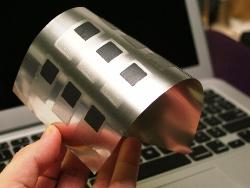 It’s no secret to anyone that batteries are firmly embedded in the everyday life of modern people. These are the power sources of our cell phones, digital cameras, camcorders, tablets and laptops - you can list endlessly. As for the accurate medical devices, portable devices, this is the most serious situation, because human life can be at stake.
It’s no secret to anyone that batteries are firmly embedded in the everyday life of modern people. These are the power sources of our cell phones, digital cameras, camcorders, tablets and laptops - you can list endlessly. As for the accurate medical devices, portable devices, this is the most serious situation, because human life can be at stake.
Despite the achievements of the battery industry, such as lithium batteries of any shape and any desired size, progress in this area does not stand still, and the next innovation is next in line - flexible battery.
This is a battery based elastic polymer. If liquefied electrolyte could cause problems related to safety due to the destruction of the release film during heating during operation, then in the case of the polymer, the stability of the materials is very, very high, according to experts from the Ulsan National Institute of Science and Technology of South Korea.
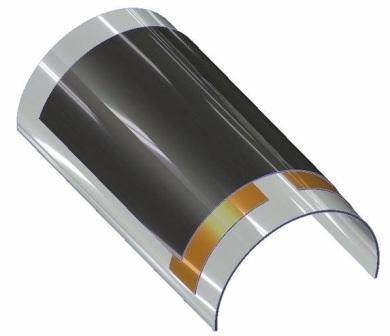
Another type of flexible battery, which can be simply printed on a special printer, offers the Californian company Imprint Energy. The company intends to use zinc in its innovation instead of traditional lithium. Zinc-polymer flexible batteries can be successfully used in wearable miniature medical electronics and in stand-alone sensors.
The use of zinc will make the batteries more compact, because zinc does not react with the environment in the same way that lithium reacts, and it can not be protected by the case, and the production itself will be completely safe. In addition, these batteries can withstand, without losing high characteristics, more than a thousand charge-discharge cycles. Such flexible and safe batteries can also be successfully used in implantable electronics.
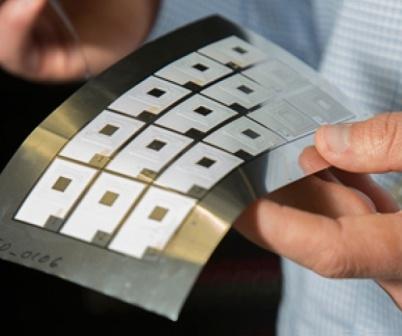
In turn, the largest Korean chemical company LG Chemical, one of the leaders in production lithium ion batteries In the world, a member of LG, recently introduced to consumers a completely new type of lithium-ion battery. The novelty looks very similar to piece of ordinary electric cable, with a diameter of about three millimeters and a length of 25 centimeters.
The device is so flexible that it can easily be tied into a knot. It can be worn as a bracelet, and if necessary, even fabric from such batteries can be made.
Chemically, the battery works like any lithium-ion counterpart. He, like any similar battery, has an anode, a lithium cobalt oxide cathode and an electrolyte. However, the components are not arranged in flat layers, but in the form of flexible spirals, similar to long thin springs.
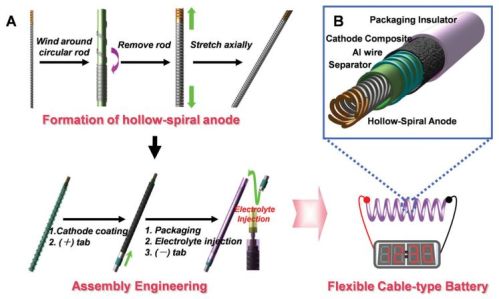
A stranded copper electrode made of copper coated with an alloy of tin and nickel acts as a cathode. This stranded wire is wound around a steel rod, the diameter of which is one and a half millimeters, and, upon completion of winding, the rod is removed. An anode with incredible flexibility is ready.
An aluminum tape is laid in a similar manner on top of the anode spiral, then the whole structure is pulled through a suspension of lithium-cobalt oxide, which, having covered the surface of aluminum, becomes the cathode. After that, the resulting cord is placed in a protective wrapper, and through the cavity that remains in the center, it is filled with liquid electrolyte, and this is the final stage in creating a flexible battery.
The flexible batteries that were created before were traditional flat forms made of flexible polymeric materials. Such batteries had a low energy storage density, and could not bend more than the plastic base could bend.
The cable type batteries offered by LG Chem have the same operating voltage and energy storage density as traditional lithium-ion batteries, but the advantage is in thinness and flexibility, which will allow you to realize absolutely fantastic things.
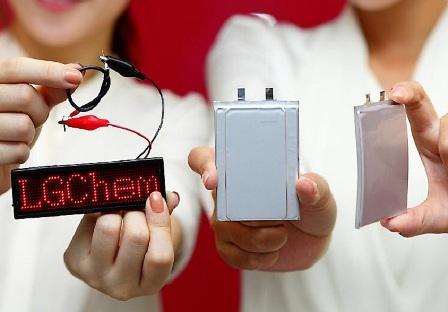
When conducting tests with cable battery, LG Chem specialists were convinced that the length of the battery cable, 25 centimeters long, was able to supply electric power to the flash player without a display continuously for 10 hours. The company's goal is the mass production of cable batteries of various sizes by mid-2017.
The prospects for use here are simply unlimited, because, as already noted, batteries are used everywhere in the modern world, and progress each time outlines newer and newer ways of developing many technologies, starting with portable electronics and ending with high-tech spacecraft, military equipment and medical devices, saving lives.
See also at e.imadeself.com
:
